
Asiana is a junior in her third year in journalism. She plays basketball and runs track. Her hobbies include drawing, listening to music, and watching...
March 3, 2022
Many have not heard of John Hartwell Cocke. Cocke was an American military officer during the War of 1812. Cocke’s parents died when he was only ten years old leaving him with nothing.
He did leave one thing behind which stands to this day: The Bremo Slave Chapel.
Cocke attended grammar school at William and Mary college, and while going there he gained knowledge of the Enlightenment and anti-slavery ideas. A few years later, when he reached twenty-one, Cocke inherited a large amount of his father’s estate.
Later, he met Ann Blaws Barruad of Norfolk, Virginia, and eventually, they got married and had six children. In 1809, they moved to Bremo to the plantation he inherited in Fluvanna County. Cocke helped in the creation of most of Fluvanna’s historical buildings like the county jail, the courthouse, and the church and temperance hall in Fork Union. One building he made was the Bremo Slave Chapel.
The Bremo slave chapel was built in 1835 at Chapel Field, which is part of the Bremo Plantation. The chapel was moved to the village of Bremo Bluff. The state’s only known slave chapel, reveals Cocke’s concern for the religious edification of his slaves. According to his journal, Cocke said the reason why he built the chapel was that he felt the slaves “had souls to be saved as well as myself and I could not get rid of the obligation I was under to provide for their moral & religious instruction.” Cocke believed he had a responsibility to teach religion to his slaves and that they were least likely to rebel as a result of that.
Cocke wanted a space where he could improve his slaves’ lives into being faithful Christians. All he wanted was “ intellectual improvement “ said Cocke (John Hartwell Cocke Journal pg. 323). He had taught his slaves to read and decided that it was his responsibility as a Christian to provide his slaves with religious instruction. Cocke and his wife, Louisa, also conducted most of the services themselves.
“In essence, Cocke believed he had a religious responsibility to teach his enslaved workers about religion,” said Tricia Johnson, the executive director of Fluvanna Historical Society. The slave chapel was made out to be a safe place for the Bremo slaves and Cocke wanted to spread the religion to them to, as he said in his journal, “make them happier, as the result of increased respectability in life, above all, prepare them for Eternity.”
The chapel still stands to this day in Bremo Bluff, but is on private land.

Asiana is a junior in her third year in journalism. She plays basketball and runs track. Her hobbies include drawing, listening to music, and watching...